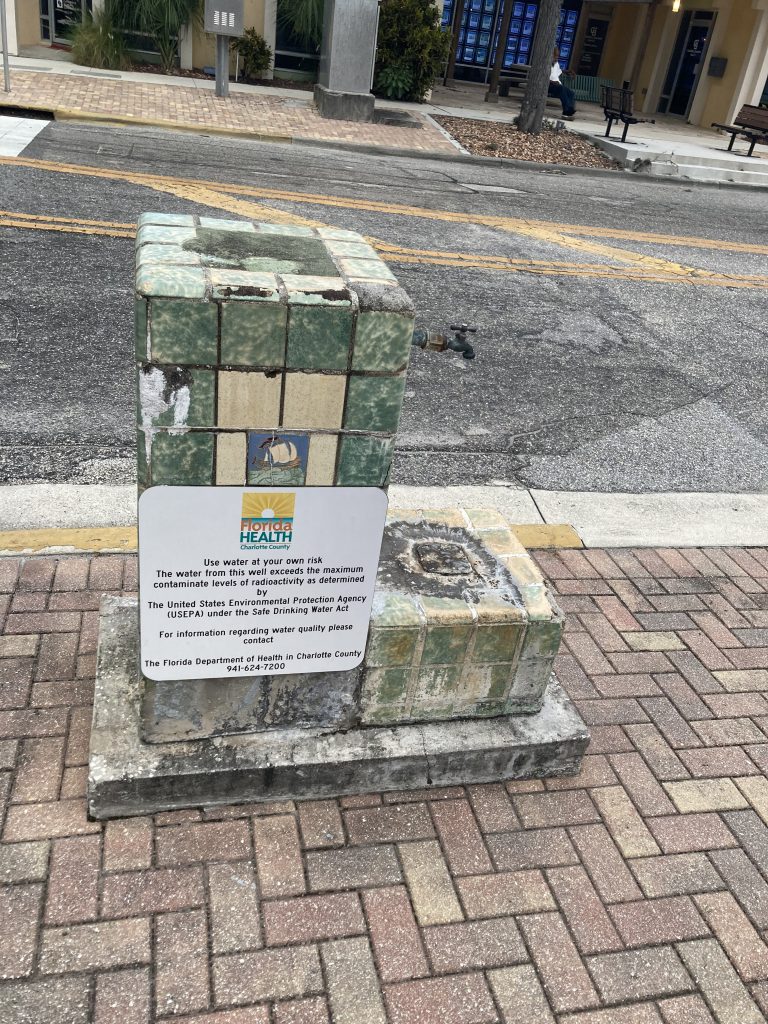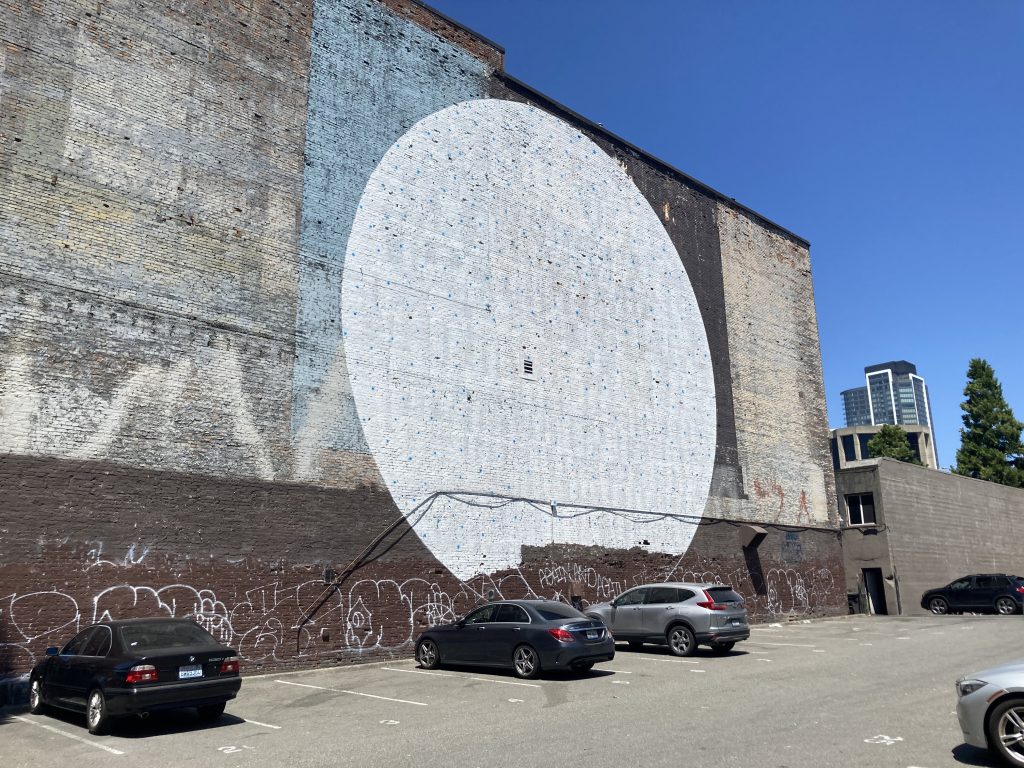
This is a personal trip, first and foremost. The goal has always been to witness, for myself, what Autumn by the Wayside describes in the dirty corners of the nation. I didn’t set out to prove anything to anyone. I don’t feel like I need to provide evidence of what I’ve seen. Autumn by the Wayside is published in several editions, available new in many major bookstores and is invariably stocked by the cartful, tattered and broken-spined, at your local second-hand retailer. It may as well be an invasive species, there.
These sites can be visited by anybody, their addresses are listed plainly. Most are open to the public for, at most, a small fee. It only takes seeing one or two of the destinations to loosen one’s steadfast sense of reality such that the rest of the book’s content seems reasonably likely to be true. It only takes seeing a dozen or so before the book becomes undeniable and… closer, somehow.
That’s the strange nature of Autumn by the Wayside. Other travel guides speak of their subjects as though they are unfamiliar. They prepare the reader for what is foreign and, in doing so, they write about a place with the assumption that it’s far away. Reading Autumn by the Wayside, one begins to feel the sense of the foreign approaching. What is familiar about a person’s hometown becomes uncanny. As the Wayside asserts itself, the notion of home dissolves. A person doesn’t need to travel to visit the Wayside. Once they recognize it, they just have to step outside their door.
I’ve gotten off-topic.
This is a personal trip- a trip about witnessing rather than writing. But the writing has become important without my realizing and it’s frustrating to see a thing like ‘The Monument, Undescribed’ and to be at a loss for words. Even Hector looks upon it in awe.
‘What can be said about ‘The Monument, Undescribed’ except that nobody can speak of the thing in regards to its physical attributes, its history, or its location?’
-traveler
‘It isn’t entirely necessary to visit ‘That Same Stupid Cloud National Park’ to see the titular slice of sky. It’s a cloud, after all, and its visible from certain viewpoints for miles around. Optimal angles aside, the park’s experience is worth the nominal cost of entry for two reasons: context and charity.
Context is important in viewing ‘The Same Stupid Cloud’ because it appears like any other except on days when it’s the only cloud in the sky or when the high-up airstreams have whipped its peers into quick movement around it. In these conditions it’s easy to see that ‘The Same Stupid Cloud’ is static both in place (above the park) and in shape (decidedly cumulus). On shape, ‘The Same Stupid Cloud National Park’ devotes the great majority of its educational displays to a friendly debate about what ‘The Cloud’ looks like. An anatomical heart? A puppy’s head? A gemstone of some sort? These are just a few of the many suggestions that have been sourced from visitors and turned into tall, difficult-to-read signs, each with a cut-out of the specific shape they detail to aid someone who might not otherwise recognize, say, a gyoza in the sky.
This brings us to the second reason to visit the park: charity. The rangers stationed at ‘The Same Stupid Cloud National Park’ have so little going for them. All park resources outside of those suggesting cloud shapes are devoted to explaining, in great detail, why exactly ‘The Same Stupid Cloud’ is anomalous and what has been done to study it. ‘The Cloud’ is a marvel, of course. It is a perfect scientific outlier, defying much of what is understood about physics and meteorology. It flies in the face of what humanity has learned of permanence and nature. It resists attempts to dispersal. It hums low tones on the winter solstice.
Recognizing all of this requires that one think really hard about the cloud or attend the annual ‘Sky Song Festival,’ neither of which the average tourist is likely to do. An hour’s pitstop is rarely enough time for a road-weary traveler to properly wrap their head around the implications of the thing- is really only enough time to empty one’s bladder and agree that the cloud does look like a pigeon, from a certain angle, as one Kumar D. pointed out in 2003. This is a source of frustration for the rangers who are, on the other hand, inevitably driven mad by the mind-bending impossibility ‘The Same Stupid Cloud’ represents.
‘The Same Stupid Cloud National Park’ earns Autumn by the Wayside’s highest recommendation, not because it stands out among the rest, but because your earnest attendance may grant a local ranger the will to see another day through to its end.’
-an excerpt, Autumn by the Wayside
My interactions with the police and other law enforcement entities have been less than ideal over the years. Some of these interactions have been covered in previous posts and those do tend to be the biggies but, speaking strictly in numbers, they represent only a fraction of the ill will I’ve accumulated in any given state. It used to be that when my budget was in the black I would rifle through my envelope of petty offenses and pay a couple off as a sign of good faith. It turns out that, past a certain limit, that sort of behavior only raises more red flags and, more importantly, alerts local governments to a person’s general whereabouts. I don’t pay tickets anymore. I don’t even keep them in an envelope. This may become an issue if I ever need to verify my credit score or take out a mortgage but practically speaking, on a day-to-day basis, it only presents a problem when a Wayside destination is government-adjacent or, in the case of ‘Planchette Airforce Base,’ so outwardly non-government as to raise suspicion.
‘A hub for UFO sightings, livestock mutilations, crashing metallic sounds, and lost time, ‘Planchette AFB’ shares a dozen qualities with New Mexico’s Area 51 but ask your local conspiracy nut about the nation’s most confounding places and ‘Planchette AFB’ won’t ever break the top 10. Why? Sheer forthcomingness in its most uncomfortable form.
‘Planchette AFB’ is chain-linked, razor-wired, and generally advertised as being off-limits by signs that cover all proper variations of ‘no trespassing’ in nearly every regional language. This has been true since its establishment in 1955. These signs were taken quite seriously until 1962 when Andrew Cabot, determined to end his life in a hail of bullets, sped toward the front gate in a pick-up truck in the clear light of day and discovered that the soldiers posted there had no intention of stopping him.
Cabot’s story prompted active explorations of the site, orchestrated mainly by members of the anti-military collective ‘Men Against War,’ which happened to be headquartered nearby. They confirmed Cabot’s claims: the soldiers at ‘Planchette AFB’ would, at most, shout at unwelcomed visitors but would never actively restrict their entry. Still, the exploration of ‘Planchette AFB’ ended up taking a long time for several reasons.
The first was simple disbelief. Despite the assurances of others, most of the ‘Men Against War’ were sure that ‘Planchette AFB’ represented a new sort of government honeypot. If trespassers weren’t already being strongarmed into bringing their fellows back to an unknown fate at the base, the soldiers were certainly keeping track of their personal details, building some sort of massive case that would see them all imprisoned in the months that followed. Cabot himself was no help in this regard. Though the brief fame seemed to distract the man from his suicidal ideations for a time, he finished the job in early 1965, hanging himself in the closet of a nearby hotel. For those already on the fence, this seemed proof enough that contact with the base was ultimately deadly.
The second factor was the complexity of the base. Though the soldiers would move to stop trespassers, several doors remained locked and several objects remained unexplained. In June 1965, for instance, members of MAW managed to break into one of the previously unentered hangars. There they discovered four 20-foot cubes, each with a perfect mirror finish and each housed as though it were an aircraft of some sort. Excitement ebbed when, after three months, nothing more could be discovered about them. They emitted no signals and sported no obvious seams. Soldiers would polish smudges from their surfaces but would not answer questions about them, claiming all information regarding the cubes was classified. Similarly, after breaching the central laboratory building in 1966, members of MAW discovered that the bulk of the structure existed underground as a series of concrete hallways randomly segmented by heavy doors. If ‘Planchette AFB’ wasn’t some sort of behavioral experiment, skeptics suggested it was simply a rat race designed to distract the public from the real deal.
The third factor was a civilian death at the hands of a soldier in 1973. The official story is that a member of MAW had a little too much to drink and became aggressive. Upon striking a soldier in the Cube Hangar, the first incident of its kind, a second soldier opened fire upon him. When the case came to court, base leaders proved that they were more than happy to suggest the dead man had been trespassing in a classified hangar when he chose to attack the soldier. Though no soldier has acted upon a civilian since, the death set a precedent for behavior on the base and likely led to the eventual dissolution of MAW.
Almost nothing has changed about ‘Planchette AFB’ since then. Soldiers rotate in and out. The facilities are maintained with seemingly needless precision. Civilians can, and still do, explore the grounds and can expect only the passive loathing and occasional shouted reproach of nearby personnel. Most importantly, nothing of interest has been discovered there since Cabot’s run despite the concentrated efforts of various travelers. ‘Planchette AFB’ represents the most uninteresting of mysteries: one with no explanation at all.’
It seems like half a century’s relative passivity would be enough to put me at ease but it doesn’t. Not even a little. So when I’m driving through the open gate of ‘Planchette AFB’ and the soldiers stationed there begin shouting at me (as research suggested they might) I still manage to slide the bike through a patch of gravel and only just catch myself on a leg that’s been twisted more times than I can count. It’s painful and embarrassing but the soldiers don’t laugh or offer to help. They just scream at me for trespassing.
When the bike’s safely upright I continue onto the base proper and, there, things quiet down a bit. I park next to a van that sports a logo for ‘Melanie’s Outta This World Tours’ and spot the group across the way. I don’t have a booking with Melanie but, as I get Hector situated in his harness, I consider following the tour to the Cube Hangar as a safety-in-numbers gambit. They’re soon joined by a red-faced officer-looking type who begins demanding that they turn back while Melanie soothes the crowd and suggests they take pictures I decide to head off on my own.
I seem to attract less attention on my own and I soon find myself deep in the mazelike basement of ‘Planchette AFB.’ After a few turns I hear a sleepy voice echo down the hall.
“Looking for me, buddy? Hey. Looking for me?”
A man is draped over the threshold of a door. It’s clear he’s been sleeping- a thick blanket suggests that he came here with an intent to sleep. His shirt indicates that he’s a ‘Planchette Busy Body,’ a volunteer that sleeps in damaged sections of the base to keep the soldiers from resecuring gained ground. They maintain an online presence to support a fairly unconvincing recruitment effort.
“I’m not looking for anyone,” I tell him.
“Fuuuuuuck,” he says, “I think they forgot about me. My guy’s, like, way overdue.”
“I’ve got some trail-mix if…”
“Anything to smoke?”
“I quit,” I tell him, “Quit a long time ago.”
“Fuuuuuuck.”
“How long are you supposed to be here?”
“I signed up for a couple days but I’m a regular. Do it every week. This guy’s supposed to have been here-” he checks his watch “-three days ago. Is Melanie around?”
“The tour group?”
“Yesss. Melanie will bum me a smoke. Would you and your rat thing sit here for me? I just want to dump the toilet and bum a smoke. I’d owe you one.”
I look down the hall behind us then back over the man’s shoulder to where the hallway seems to fork. Totally quiet. Completely still. “You can’t just sneak out real quick?”
“Some places you can, man,” he says, “Cuz in a lot of these places we’ve hacked the codes or copied the keys so it doesn’t matter if doors get shut. Our people couldn’t crack this one so they just melted the hinges off.” The man gestures to deep metal scars on either side of the frame. “And it’s a pinch point. If they put this back, they cut off half the facility. What I’m saying is, it’s an important door. What’s five minutes to you?”
I have no answer and with that the man abandons me. Hector and I sit in the door frame for an hour. Two hours. Every time I determine to leave I seem to hear boots clicking just out of sight and I make myself stay for the sake of progress on the Wayside and because I worry that the man’s sleeping in this doorway means others are sleeping further ahead. Would base officials consider them before replacing the door, or would they seal them inside, setting a new precedent with which to enforce the seriousness with which they view trespassers? My opinion of government accountability is grim, to say the least, and the worry anchors me.
Footfalls wake Hector and Hector eventually wakes me. Eight hours have passed and a womans appeared, hesitating at an intersection ahead of us. I think to call out just as she’s about to turn down a different way.
“Hey!” I call. “Hey! Are you looking for me?”
-traveler
‘It’s painful to think that someone down the line felt the need to insinuate a rhyme into the name ‘The Tall Drain of Central Maine’ but that is its common title. Speaking literally, it seems to be the mostly-intact plumbing system of a three-story building that has since fallen away. It is unlikely that this configuration occurred naturally, but nobody has yet explained how the pipes could be extracted so wholly and with so little notice. Or why.
Rainwater enters the system through sinks and toilets held aloft in the network. It funnels downward and exits through a dribbling faucet at the base. That’s the theory, anyway. The truth is that water seems to be available at the tap at all times, even after months of little or no precipitation. What aren’t up for debate, but should be, are the supposed boons granted by the water and the means by which it is changed in the drain.
There are those who believe a chemical change has taken place, that the water is imbued by the metal of ‘The Tall Drain of Central Maine’ or steeped in something biological that grows there. There is some overlap between those who recognize occult signs in the arrangement of pipes and those who suspect magnetism may be involved. A handful believe that the ‘The Tall Drain of Central Maine’ was designed to filter mana from the clouds but they are far and wide the black sheep of these speculators.’
The entry fails to mention the creaking of the ramshackle pipes, shrill and unpredictable. It can be heard a long ways off and rumor suggests that it’s responsible for ‘The Tall Drain of Central Maine’s’ overall lack of birds. Birds exist in noisier climates, sure, but not here. Something about the sound of it is off, even to my ears.
It energizes Hector. For the first time in our relatively short acquaintance, he’s pulling me by the leash. He leads me to the faucet at the base, or as close as I let him get. There’s a small line of sickly people, there, each taking swigs of the gray slurry leaking from the base. I tug Hector back but he manages a sip of the liquid from where it’s puddled on the ground. He keels over so quickly I wonder if he hasn’t been concealing a penchant for slapstick under that world-worn exterior.
But the moment passes and Hector is still and heavy and when I give the leash an encouraging tug he drags a few dead inches and moves no more.
It isn’t until I’ve taken his body past the line and far away from ‘The Tall Drain of Central Maine’ that his heart spasms under his leather and he kicks himself back to life and stares, wide-eyed and frightened at the world around him.
Hector takes fitfully to his renewed sight, thrashing in the kennel for nearly a week before settling into a few brief and uneasy public forays.
I keep a sample flask of the slurry sealed up in my pouch in my bag, unwilling to try it myself. Who knows what it would restore in me?
-traveler
‘Smack dab in the middle of Delaware, ‘The Electric Potato Farm’ is in the news for killing, again. It has expanded past its known borders, pulling barbed wire and earth where even those who take the necessary precautions may be caught off guard. Experts further suggest the density of potatoes in the field has doubled in recent years. So much as brushing the network with bare skin is 30% more likely to result in a fatality. Multiple fatalities are common as friends and family attempt to rescue downed loved ones.
The Delaware Supreme Court recently ruled against broad penalties for restaurants that claimed to serve potatoes from ‘The Electric Potato Farm.’ Many do, it seems. How they harvest them from the metal network, who they get to do the harvesting: these things are considered trade secrets.
‘The Electric Potato Farm’ is not public land, exactly, but no private party claims it. There are lawsuits waiting for anyone who does. A farmhouse stands in the center of the field, ruined enough to imply abandonment. A barbwire coil dwindles inside, charged by the potatoes in the field and drawn out by their roots. The consensus is that the problem will solve itself eventually- a virus unspooling in the outskirts.’
-an excerpt, Autumn by the Wayside
Rear View Mirror
- February 2025
- January 2025
- December 2024
- November 2024
- October 2024
- September 2024
- August 2024
- July 2024
- June 2024
- May 2024
- April 2024
- March 2024
- February 2024
- January 2024
- December 2023
- November 2023
- October 2023
- September 2023
- August 2023
- July 2023
- June 2023
- May 2023
- April 2023
- March 2023
- February 2023
- January 2023
- December 2022
- November 2022
- October 2022
- September 2022
- August 2022
- July 2022
- June 2022
- May 2022
- April 2022
- March 2022
- February 2022
- January 2022
- December 2021
- November 2021
- October 2021
- September 2021
- August 2021
- July 2021
- June 2021
- May 2021
- April 2021
- March 2021
- February 2021
- January 2021
- December 2020
- November 2020
- October 2020
- September 2020
- August 2020
- July 2020
- June 2020
- May 2020
- April 2020
- March 2020
- February 2020
- January 2020
- December 2019
- November 2019
- October 2019
- September 2019
- August 2019
- July 2019
- June 2019
- May 2019
- April 2019
- March 2019
- February 2019
- January 2019
- December 2018
- November 2018
- October 2018
- September 2018
- August 2018
- July 2018
- June 2018
- May 2018
- April 2018
- March 2018
- February 2018
- January 2018
- December 2017
- November 2017
- October 2017
- September 2017
- August 2017
- July 2017
- June 2017
- May 2017
- April 2017
- March 2017
- February 2017
- January 2017
- December 2016
- November 2016
- October 2016
- September 2016
- August 2016




